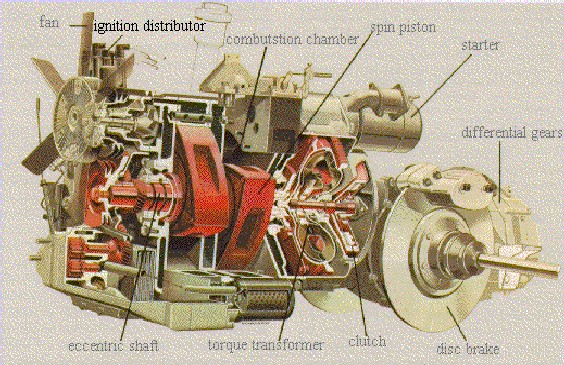ROTARY ENGINE
The Wankel engine is a rotary motor. At one time Peugeot
used it in a production car and MAZDA still uses the Wankel in some of
its models Here are various advantages:
- For gas control no valves and connecting rods are needed.
- Its weight is very low in comparison to a piston engine.
- Its volume is about half that of the piston engine with
the same power.
- The production costs are lower compared to other motor
types.
- It can reach higher revolutions per minute.
DESCRIPTION OF THE 4 CYCLES OF THE WANKEL ENGINE
- After all consumption gases have been pressed out (see
colour black and a) the intake cycle begins. Petrol air mixture
flowes through the inlet channel into the blue chamber.The piston rotates
to the left and compresses the fresh gas.
Chamber a sucks in fresh gas, while chamber b starts to compress
the gas. In chamber c the gas is completely burned and can flow
out (see black colour).
- Chamber a sucks in petrol air mixture. Chamber
b has compressed the gas completely. Now two ignition sparks ignite
the compressed gas simultaneously. Chamber c presses out the burned
gases.
- Chamber a is full of fresh gas. The compression
cycle begins as soon as chamber a is closed. In chamber c
the burned gases decompress and press the piston into spin direction. Meanwhile
chamber c presses out burned gases.
Sources: "DAS WILL ICH VON DER TECHNIK WISSEN",
AUTHOR: AXEL REX and BOMIN SOLAR, SIGNON SAN DIEGO,
FUTURE DRIVE, WORLD WATCH.
Back to CONVENTIONAL COMBUSTION ENGINES
or CAR OF THE FUTURE


